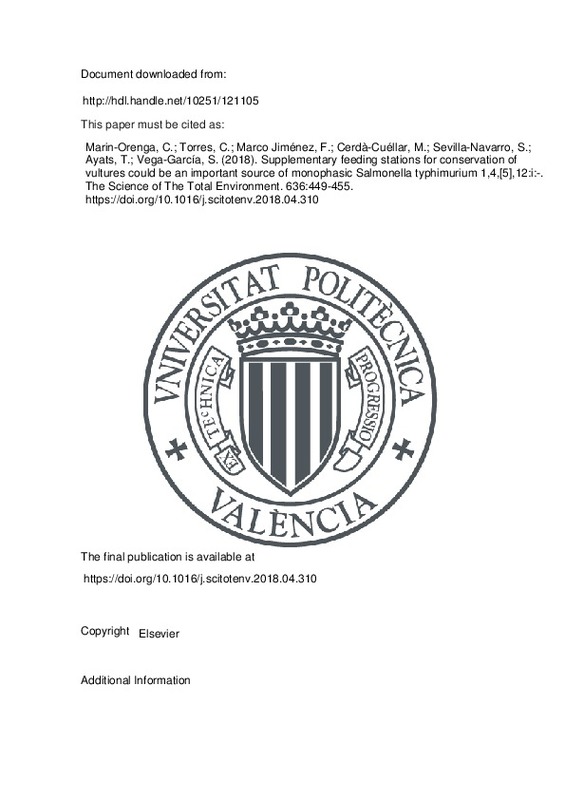JavaScript is disabled for your browser. Some features of this site may not work without it.
Buscar en RiuNet
Listar
Mi cuenta
Estadísticas
Ayuda RiuNet
Admin. UPV
Supplementary feeding stations for conservation of vultures could be an important source of monophasic Salmonella typhimurium 1,4,[5],12:i:-
Mostrar el registro sencillo del ítem
Ficheros en el ítem
| dc.contributor.author | Marin-Orenga, Clara
|
es_ES |
| dc.contributor.author | Torres, Cristobal
|
es_ES |
| dc.contributor.author | Marco Jiménez, Francisco
|
es_ES |
| dc.contributor.author | Cerdà-Cuéllar, Marta
|
es_ES |
| dc.contributor.author | Sevilla-Navarro, Sandra
|
es_ES |
| dc.contributor.author | Ayats, Teresa
|
es_ES |
| dc.contributor.author | Vega-García, Santiago
|
es_ES |
| dc.date.accessioned | 2019-05-26T20:02:47Z | |
| dc.date.available | 2019-05-26T20:02:47Z | |
| dc.date.issued | 2018 | es_ES |
| dc.identifier.issn | 0048-9697 | es_ES |
| dc.identifier.uri | http://hdl.handle.net/10251/121105 | |
| dc.description.abstract | [EN] Vultures are nature's most successful scavengers, feeding on the carcasses of dead animals present in the field. Availability of domestic carrion has been unstable due to rapidly changing agro-grazing economies and increasing sanitary regulations that may require burial or burning of livestock carcasses. Thus, several griffon vulture (Gyps fulvus) recoveries are based on European legislation that guarantees the animals' welfare, avoids intense persecution of the vultures and allows the feeding of threatened wildlife in supplementary feeding stations (SFS). However, in recent years, many studies have speculated on the likelihood that avian scavengers may be infected by feeding on pig carcasses at SFS from intensive livestock. In this context, the present study evaluated whether free-living griffon vultures and pig farms share zoonotic Salmonella strains to test the hypothesis that vulture are infected during consumption of carcasses provided at SFS. Here, the occurrence, serotypes and genomic DNA fingerprinting (phage typing and pulsed-field gel electrophoresis) of isolated strains were carried out in griffon vultures and pig farms authorised to provided carcasses at SFS in Castellón province (eastern Spain). The bacteriological analyses revealed that 21.1% of vultures and 14.5% for pig farms samples tested were Salmonella-positive. Monophasic S. typhimurium 1,4,[5],12:i:- was the most frequently isolated serovar. Comparison of Salmonella strains isolated from vultures and pig farms revealed that monophasic S. typhimurium 1,4,[5],12:i:-, S. Derby and S. Rissen strains were highly genetically homogeneous (similar DNA fingerprint). In conclusion, the current study indicates that free-living griffon vultures and pig farms that provide the carcasses at SFS share several zoonotic Salmonella strains. On this basis, and although transmission could be bidirectional, our result seems to corroborate the pig carcasses-to-vulture transmission and cross-infection at SFS. As an immediate Salmonella control strategy in wild avian scavengers, we suggest the implementation of a programme to guarantee that solely pig carcasses from Salmonella-free farms arrive at SFS. | es_ES |
| dc.description.sponsorship | Funding grants from the Ministry of Infrastructures, Territory and Environment (Regional Government/Generalitat Valenciana) and from CEU-UCH (Consolidacion de Indicadores INDI15/16, INDI16/20, INDI17/25) are acknowledged. CERCA Programme from the Generalitat de Catalunya is also acknowledged. | es_ES |
| dc.language | Inglés | es_ES |
| dc.publisher | Elsevier | es_ES |
| dc.relation.ispartof | The Science of The Total Environment | es_ES |
| dc.rights | Reconocimiento - No comercial - Sin obra derivada (by-nc-nd) | es_ES |
| dc.subject | Avian scavengers | es_ES |
| dc.subject | Intensive fanning | es_ES |
| dc.subject | Pig | es_ES |
| dc.subject | Environment | es_ES |
| dc.subject | Salmonella Derby | es_ES |
| dc.subject | Salmonella Rissen | es_ES |
| dc.subject.classification | PRODUCCION ANIMAL | es_ES |
| dc.title | Supplementary feeding stations for conservation of vultures could be an important source of monophasic Salmonella typhimurium 1,4,[5],12:i:- | es_ES |
| dc.type | Artículo | es_ES |
| dc.identifier.doi | 10.1016/j.scitotenv.2018.04.310 | es_ES |
| dc.rights.accessRights | Abierto | es_ES |
| dc.contributor.affiliation | Universitat Politècnica de València. Departamento de Ciencia Animal - Departament de Ciència Animal | es_ES |
| dc.description.bibliographicCitation | Marin-Orenga, C.; Torres, C.; Marco Jiménez, F.; Cerdà-Cuéllar, M.; Sevilla-Navarro, S.; Ayats, T.; Vega-García, S. (2018). Supplementary feeding stations for conservation of vultures could be an important source of monophasic Salmonella typhimurium 1,4,[5],12:i:-. The Science of The Total Environment. 636:449-455. https://doi.org/10.1016/j.scitotenv.2018.04.310 | es_ES |
| dc.description.accrualMethod | S | es_ES |
| dc.relation.publisherversion | https://doi.org/10.1016/j.scitotenv.2018.04.310 | es_ES |
| dc.description.upvformatpinicio | 449 | es_ES |
| dc.description.upvformatpfin | 455 | es_ES |
| dc.type.version | info:eu-repo/semantics/publishedVersion | es_ES |
| dc.description.volume | 636 | es_ES |
| dc.relation.pasarela | S\361280 | es_ES |
| dc.contributor.funder | Generalitat Valenciana | |
| dc.contributor.funder | Universidad CEU Cardenal Herrera |







![[Cerrado]](/themes/UPV/images/candado.png)

